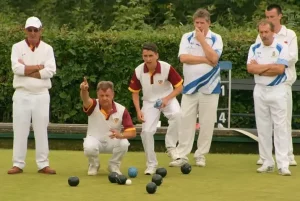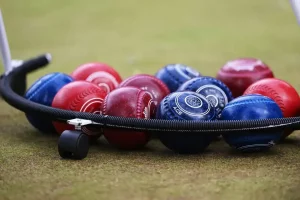Lawn bowling entails more than just rolling a ball towards a target. Like any other game, it adheres to a specific set of rules that govern the gameplay. These rules outline the proper way to play, what is permissible, what is forbidden, and various other aspects of the game.
If you’re considering giving the game a try, it’s worth reading this article all the way through. Here, we’ll provide you with the essential rules of lawn bowling that every beginner should know.

Contents
Basic Lawn Bowling Rules
If you’re already familiar with lawn bowling, great! But in case you’re not, let me fill you in. Lawn bowling, also known as lawn bowls, is a unique variation of bowling that differs from regular ten-pin bowling and shares similarities with Bocce. The game involves rolling biased balls, which are not perfectly round, across a smooth lawn called flat green bowls. The objective is to get the balls as close to the target as possible. It’s a delightful sport that combines precision and strategy in a picturesque setting.
Bowls consistently follow a curved trajectory, requiring players to devise strategic approaches for desired outcomes. Though seemingly straightforward, the game is governed by several rules that provide structure and enhance enjoyment for casual and competitive players alike.

Before delving into the more intricate rules of lawn bowls, it’s crucial to familiarize ourselves with the fundamentals. This ensures that we can navigate through the upcoming information without feeling overwhelmed. Here, we present the foundational rules of lawn bowling, tailored specifically for beginners:
Setting Up, Deciding Play Order, and Gathering Equipment
Setting up a game of lawn bowling involves several steps. While it may appear overwhelming initially, you’ll quickly become familiar with the process through practice. Here’s a breakdown of what needs to be done:
Find a Spot to Play
Lawn bowling is best enjoyed on a bowling green, a rectangular flat expanse of lush grass. When you find yourself at a lawn bowling club, simply select a rink and let the fun begin!
As you delve into the world of lawn bowling, you may encounter different variations of the sport. One such variation is Crown Green Bowls, which shares similarities with traditional lawn bowls. However, instead of playing on a level surface, Crown Green Bowls takes place on a field featuring a raised center surface. This unique twist adds an extra layer of excitement and challenge to the game.
Decide on Play Structure
The game can be enjoyed with just 2 players or with a larger group of up to 8 people, who can form teams. In terms of player count, there are four different variations available.
- Individual
- Duos
- Trios
- Quads
The number of bowls played per end (round) varies based on the number of players in the game. In singles and doubles matches, each player will roll four bowls. For triple matches, players will roll three bowls. In four-player matches, two bowls will be rolled by each player. This ensures fairness and balance in the game, allowing players to showcase their skills and strategy.
Get Your Equipment
Once you’ve determined the play structure, the next step is acquiring the appropriate equipment. Here’s a list of what you’ll need:
- To play the game, you will need the following items:
- A set of bowls (balls) for each player. All players must use the same set to ensure fairness.
- A coin or any other means to determine who goes first.
- A small white ball, also known as the jack.
- Flat shoes for comfortable playing.
- A foot mat to provide a designated area for the game.
- A measuring tool to ensure accurate measurements.
- Chalk or Chalk Spray for marking the playing area.
To ensure a delightful and equitable game of bowls, these items are indispensable. With your equipment at the ready and all other matters settled, you’re prepared to progress to the next stage.
Decide Game Length
Before proceeding, it is important to determine the duration of the game. You have several options to choose from: setting a time limit (1, 2, or 3 hours), specifying a certain number of points (shots), or establishing a maximum number of ends (rounds). In formal competitions, Lawn Bowl is typically played over 18 or 21 ends. It is crucial to make this decision in advance to avoid any potential issues later on.
Other Lawn Bowling Rules You Need to Know
While the aforementioned rules may seem overwhelming, they are not the sole guidelines one must comprehend to play the game fairly. Allow me to introduce a selection of additional lawn bowling rules that beginners should acquaint themselves with.

Mark the Toucher
In the game of lawn bowls, a “toucher” refers to a bowl that makes contact with the jack before the subsequent bowl is delivered. Touchers hold a special significance as they remain active bowls, even if they end up in the ditch surrounding the rink, as long as the jack is still in play. On the other hand, non-toucher bowls that find their way into the ditch are considered out of play and are subsequently removed.
To indicate a toucher, promptly mark the bowl with chalk after it comes to a stop and before the next bowl is released. The marker, whether a player or an umpire, usually employs a piece of chalk or chalk spray to create a small mark on the bowl. This chalk mark serves as a signal to all players that the bowl is a toucher.
If a potential toucher is not designated before the next bowl is thrown, it forfeits its toucher status. Typically, the responsibility of marking touchers lies with the player who delivered the bowl, their team, or the marker in a singles match.
The regulations regarding touchers and how they are marked may differ slightly among various lawn bowling clubs and associations. Therefore, it is advisable to acquaint yourself with the specific rules of the venue where you intend to play. By doing so, you can enhance your understanding and ensure a smooth and enjoyable experience.
Where to Stand During Play
Understanding your position during gameplay is crucial. If you’re not the one throwing a bowl, position yourself on the opposite side of the rink, behind the jack. If the jack is in a ditch, those who aren’t throwing a bowl should stand on the surrounds of the green. By following these guidelines, you can ensure smooth gameplay and maintain the integrity of the game.
It is of utmost importance to avoid other playing areas to not disrupt fellow players. This not only demonstrates proper etiquette but also fosters a serene and concentrated atmosphere for all participants. Lawn Bowls, a game that demands precision and focus, can be greatly impacted by unnecessary disturbances, potentially affecting a player’s performance.
Exhibiting proper etiquette holds equal significance in lawn bowling as it does in other forms of bowling.
Make Sure the Mat Doesn’t Move Around
To ensure a fair game, it is important to prevent the mat from shifting during play. Consistency is key, and each player should deliver their bowl from the same spot. Therefore, if the mat happens to move from its initial position, take a moment to carefully readjust it. This small action will help maintain the integrity and balance of the game.
Ensuring the stability of the mat is not only a matter of fairness but also of preserving the strategic elements of the game. Players make decisions based on the current state of play, taking into account the position of the mat. If the mat shifts, it can invalidate these strategies, disrupting the flow and the tactical essence of the game.
Know What Constitutes a Dead Bowl
In the game of lawn bowls, a bowl is deemed “dead” when it comes to rest beyond the boundaries of the rink. This includes landing in the ditch without making contact with the jack, which would classify it as a toucher. Furthermore, if a bowl is knocked out of the rink or displaced by another bowl during its course, it is also considered “dead.”
Bowls that are deemed dead are eliminated from play and do not contribute to the scoring for that particular end. It’s important to note that the precise regulations outlining when and how bowls are declared dead may slightly differ across various clubs and associations.
In certain instances, if a bowl delivered does not travel a distance of at least 14-20 meters (45.93-65.62 feet) (depending on the competition’s specific rules), it may be deemed as a “dead” bowl. This rule is in place to ensure a certain level of skill is demonstrated in delivering the bowls.
When to Calculate Shots
In the game of lawn bowls, shots are tallied after each “end.” An end is considered complete when all players or teams have thrown all of their bowls. It is at this juncture that the players or teams will ascertain the score for that particular end.
To ensure an accurate score, it is crucial to wait until all bowls have been thrown before determining the final count. The position of the bowls, and consequently the score, can change with each throw. Additionally, players should refrain from moving any bowls until the score has been agreed upon, guaranteeing a precise tally.
Once all the bowls have been gathered, the subsequent end commences. This pattern persists throughout the game, and upon reaching the predetermined number of ends, the overall score is tallied.
Conclusion
These fundamental rules provide a solid foundation for understanding the game of lawn bowls. By familiarizing yourself with these regulations, you can confidently begin your journey as a lawn bowler.
Remember to always stay courteous and respectful towards other players, and have fun! As you continue to play and gain experience, you may come across additional guidelines that are specific to certain competitions or clubs. Be sure to stay informed and always ask for clarification if needed. Lawn bowls are a unique and enjoyable sport, so get out there and give it a try! So, whether you are a beginner or an experienced player, these rules will help ensure that everyone can enjoy the game of lawn bowls.
Keep practicing, have fun, and you may just become a lawn bowls champion. Keep in mind, these rules are not exhaustive and there may be other specific rules to keep in mind depending on the location and type of competition. Always make sure to thoroughly read the rules before playing to ensure a fair and enjoyable game for all. So grab your bowls, head out to the green, and have a great time playing this timeless sport.


Allow me to introduce myself – I’m Eric Wilkinson, a true bowling aficionado. The world of bowling culture has always fascinated me, and I’ve made the exciting decision to share my passion through writing. As I embark on this blogging adventure, my goal is to provide fellow enthusiasts with valuable insights, tips, and captivating stories. Through my blog, I hope to ignite a deeper appreciation for the sport and foster a sense of community among fellow bowlers. Join me on this thrilling journey as we explore the vibrant world of bowling together.
